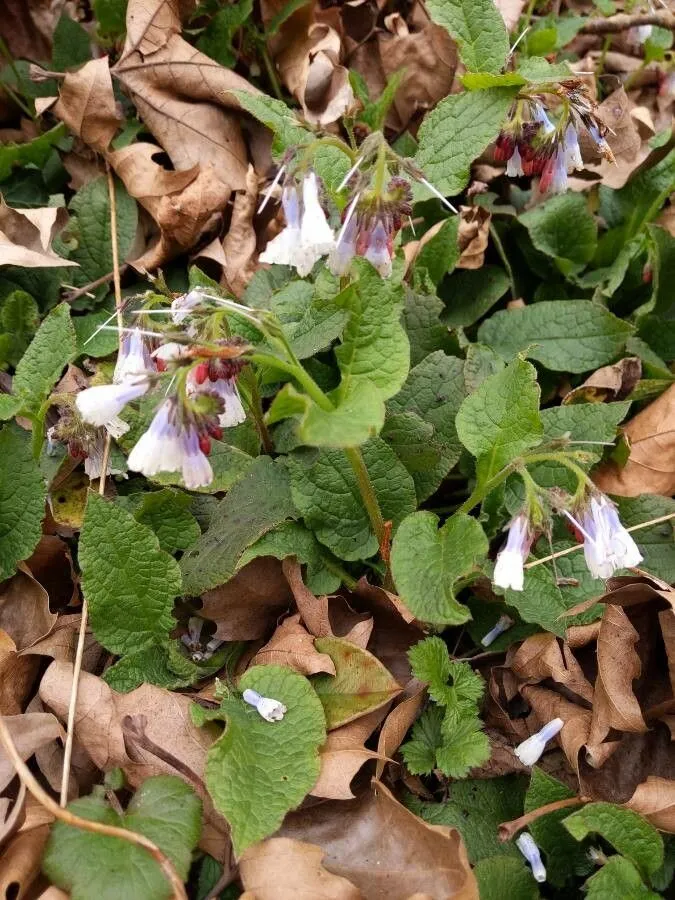
Author: Lepech.
Bibliography: Nova Acta Acad. Sci. Imp. Petrop. Hist. Acad. 14: 442 (1805)
Year: 1805
Status: accepted
Rank: species
Genus: Symphytum
Vegetable: False
Observations: NE. Türkiye to NW. & N. Iran
Rough comfrey, known scientifically as Symphytum asperum, is an herbaceous perennial plant belonging to the family Boraginaceae. This hardy, resilient plant is native to the northeastern region of Türkiye, extending to the northwestern and northern areas of Iran.
One of the distinguishing features of Rough comfrey is its coarse, bristly leaves, which contribute to its descriptive common name. The leaves exude a rough texture, which, combined with the plant’s dense foliage, provides a robust presence in its natural habitat. Rough comfrey typically thrives in woodlands, meadows, and along stream banks where it can access ample moisture and partial sunlight.
The plant comes into bloom with clusters of bell-shaped flowers, usually appearing in shades of blue or purple, which are particularly attractive to various pollinators including bees and butterflies. These delicate blossoms not only add visual charm to the landscape but also play a significant role in supporting local ecosystems by providing nectar.
In terms of its botanical background, Rough comfrey was first described and recorded in detail in the early 19th century. The definitive description was published in 1805 in the “Nova Acta Academiae Scientiarum Imperialis Petropolitanae” (Volume 14, page 442) by the botanist Lepechin. This historical documentation underscores the plant’s long-recognized presence and importance in botanical studies.
Furthermore, Rough comfrey has been used traditionally in herbal medicine, similar to other members of the Symphytum genus. Despite its medicinal potential, it’s worth noting that the plant contains certain alkaloids which may be toxic if not used correctly. Therefore, its use in traditional remedies is approached with caution, adhering to knowledgeable practices to harness its benefits safely.
In summary, Symphytum asperum, or Rough comfrey, is a notable species in the Boraginaceae family, valued both for its ecological contributions and its historical significance in the realm of botany. Its presence from northeastern Türkiye to northern Iran highlights its adaptability and the crucial role it plays in these regions’ natural biodiversity.
Fin: ahosilmäruoho, pikkusormustinkukka, sormustinkukka, tanakkasilmäruoho, tarharaunioyrtti
Dan: almindelig fingerbøl, gul fingerbøl, kort øjentrøst, ru kulsukker
Ita: consolida ruvida
Fra: consoude hérissée, consoude rude, consoude rugueuse, consoude âpre
Swe: fingerborgsblomma, finnögontröst, grå ögontröst, liten fingerborgsblomma, fodervallört, tarharaunioyrtti, taggvallört
Nor: gråaugnetrøst, gul revebjølle, revebjølle
Deu: komfrey, rauer beinwell, rauher beinwell
Eng: prickly comfrey, rough comfrey
Spa: consuelda, consueldo del cáucaso
Nob: fôrvalurt, forvalurt
Nno: fôrvalurt
Est: kare varemerohi
Ces: kostival drsný
Lav: skabr, skarb
Nld: ruwe smeerwortel
Cym: cyfardwf arw, cyfardwf garw
En: Rough comfrey, Prickly comfrey
Cs: Kostival drsný
Da: Almindelig Fingerbøl, Gul Fingerbøl, Kort Øjentrøst, Ru kulsukker
Nl: Ruwe smeerwortel
Et: Kare varemerohi
Fi: Ahosilmäruoho, Pikkusormustinkukka, Sormustinkukka, Tanakkasilmäruoho, Tarharaunioyrtti
Fr: Consoude rude, Consoude rugueuse, Consoude hérissée, Consoude âpre
De: Komfrey, Rauer Beinwell, Rauher Beinwell, Rauhe Wallwurz
It: Consolida ruvida, Consolida aspra
Lv: Skabr, Skarb
No: Gråaugnetrøst, Gul Revebjølle, Revebjølle
Nb: Fôrvalurt, Forvalurt
Nn: Fôrvalurt
Ru: Okopnik sherohovaty
Es: Consuelda, Consueldo del Cáucaso
Sv: Fodervallört, Fingerborgsblomma, Finnögontröst, Grå ögontröst, Liten fingerborgsblomma, Tarharaunioyrtti, Taggvallört
Cy: Cyfardwf Arw, Cyfardwf Garw
Taken Apr 23, 2020 by Céline Barbieri (cc-by-sa)
Taken May 17, 2019 by Kseniia (cc-by-sa)
Taken May 7, 2018 by Anton Heuven (cc-by-sa)
Taken May 12, 2018 by FERDINAND AHL (cc-by-sa)
Taken May 9, 2019 by sylvie soares (cc-by-sa)
Taken Mar 16, 2022 by Gaël Covain (cc-by-sa)
Taken Jun 6, 2020 by Павел333 Павел333 (cc-by-sa)
Taken Jun 6, 2022 by Marta Klajnert (cc-by-sa)
Taken May 7, 2022 by Hmdy Akn (cc-by-sa)
Taken Jul 6, 2022 by Rolf Lindhamn (cc-by-sa)
© copyright of the Board of Trustees of the Royal Botanic Gardens, Kew.
© copyright of the Board of Trustees of the Royal Botanic Gardens, Kew.
© copyright of the Board of Trustees of the Royal Botanic Gardens, Kew.
Taken May 26, 2021 by Sabina Hartmann (cc-by-sa)
Taken May 11, 2020 by Sabina Hartmann (cc-by-sa)
Taken Jun 16, 2020 by Frozy
Taken May 3, 2020 by Aiguail (cc-by-sa)
Taken Mar 16, 2022 by Gaël Covain (cc-by-sa)
Taken May 3, 2022 by Edward Leenders (cc-by-sa)
Taken Apr 9, 2021 by Baya Ferroudj (cc-by-sa)
Taken Jul 15, 2019 by Photoflora – Benoit BOCK (©)
Taken Jul 15, 2019 by Photoflora – Benoit BOCK (©)
Taken Jun 16, 2020 by Frozy
Taken Jul 15, 2011 by Photoflora – Benoit BOCK (©)
Taken Jul 15, 2011 by Photoflora – Benoit BOCK (©)
Taken May 15, 2022 by Else Nolden (cc-by-sa)
Taken Jul 15, 2019 by Photoflora – Benoit BOCK (©)
Taken Jul 15, 2019 by Photoflora – Benoit BOCK (©)
Taken May 16, 2020 by Nicola Dempster (cc-by-sa)
Taken Jul 15, 2011 by Photoflora – Benoit BOCK (©)
Taken Jul 15, 2019 by Photoflora – Benoit BOCK (©)
Growth habit: Forb/herb
Ph maximum: 8.0
Ph minimum: 7.5
Light: 8
Atmospheric humidity: 5
Soil nutriments: 8
Family: Myrtaceae Author: (F.Muell.) K.D.Hill & L.A.S.Johnson Bibliography: Telopea 6: 402 (1995) Year: 1995 Status:…
Family: Rubiaceae Author: Pierre ex A.Froehner Bibliography: Notizbl. Bot. Gart. Berlin-Dahlem 1: 237 (1897) Year:…
Family: Sapindaceae Author: Koidz. Bibliography: J. Coll. Sci. Imp. Univ. Tokyo 32(1): 38 (1911) Year:…
Family: Asteraceae Author: A.Gray Bibliography: Pacif. Railr. Rep.: 107 (1857) Year: 1857 Status: accepted Rank:…
Family: Fabaceae Author: Medik. Bibliography: Vorles. Churpfälz. Phys.-Ökon. Ges. 2: 398 (1787) Year: 1787 Status:…
Family: Aspleniaceae Author: (Cav.) Alston Bibliography: Bull. Misc. Inform. Kew 1932: 309 (1932) Year: 1932…